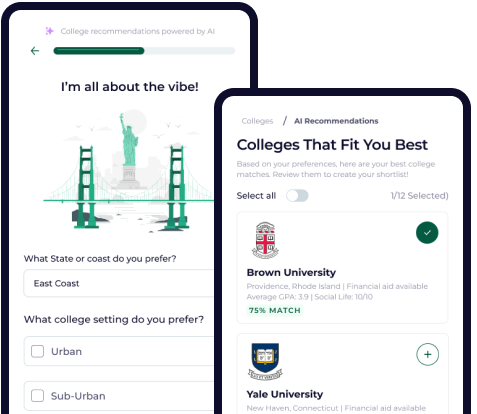 Trusted by ~100k students and parents
Trusted by ~100k students and parents
Your One-Stop Solution for College Apps
From finding your dream college to scoring scholarships, acing essays, and making your extracurriculars shine—Kollegio is your go-to for all things college prep.
Discover colleges near and far
Find hundreds of scholarships
Brainstorm and review essays
Get feedback on activities
Plan your college application
Discover colleges near and far
Find hundreds of scholarships
Brainstorm and review essays
Get feedback on activities
Plan your college application
Discover colleges near and far
Find hundreds of scholarships
Brainstorm and review essays
Get feedback on activities
Plan your college application
Discover colleges near and far
Find hundreds of scholarships
Brainstorm and review essays
Get feedback on activities
Plan your college application
Our mission
We're changing the way the next Gen goes to college - for free!
Find colleges and programs made for YOU
Scholarships that don't ghost you
Don't just take it from us

Annabel
Portola High School, California
College applications can be very stressful but Kollegio has made it much easier! I can see which colleges fit my preferences based on my profile and get detailed feedback for all my essays. Best of all, everything is completely free! Would definitely recommend!

Meher
Edison High School, New Jersey
Kollegio has really helped me with evaluating my essays and getting quick feedback on my essay structure! It's a much needed companion tool to the traditional college admission services, and I'm so glad that it's free because every student can benefit from it

Claryssa
Community college, California
Kollegio helped me brainstorm ideas for essays that were tailored to my experiences, while still giving me the freedom and creativity to write my essays entirely on my own. Their support made applying to college smoother and more personal, allowing me to tell my story authentically.

Cyril Akakpo
Akosombo international school, Ghana
Kollegio has really helped me with evaluating my essays and getting quick feedback on my essay structure! It's a much needed companion tool to the traditional college admission services, and I'm so glad that it's free because every student can benefit from it
Powered by ai
Make your perfect college list in minutes
list in minutes
Let our AI college recommender curate your college list
- Answer a few questions and get matched with your best fit colleges!
- Our AI analyzes your information to match you with colleges that suit you perfectly.
- Create an account on Kollegio to save this shortlist and plan your application journey.

Your guide to college success

A Guide to Colleges with Acceptance Rates Below 25%
Stay up to date with everything related to college admissions
Want the latest news from Kollegio?
Visit our blog
meet us where you are
Together lets make a difference
Want to boost your resume, and help your peers discover their dream colleges?


